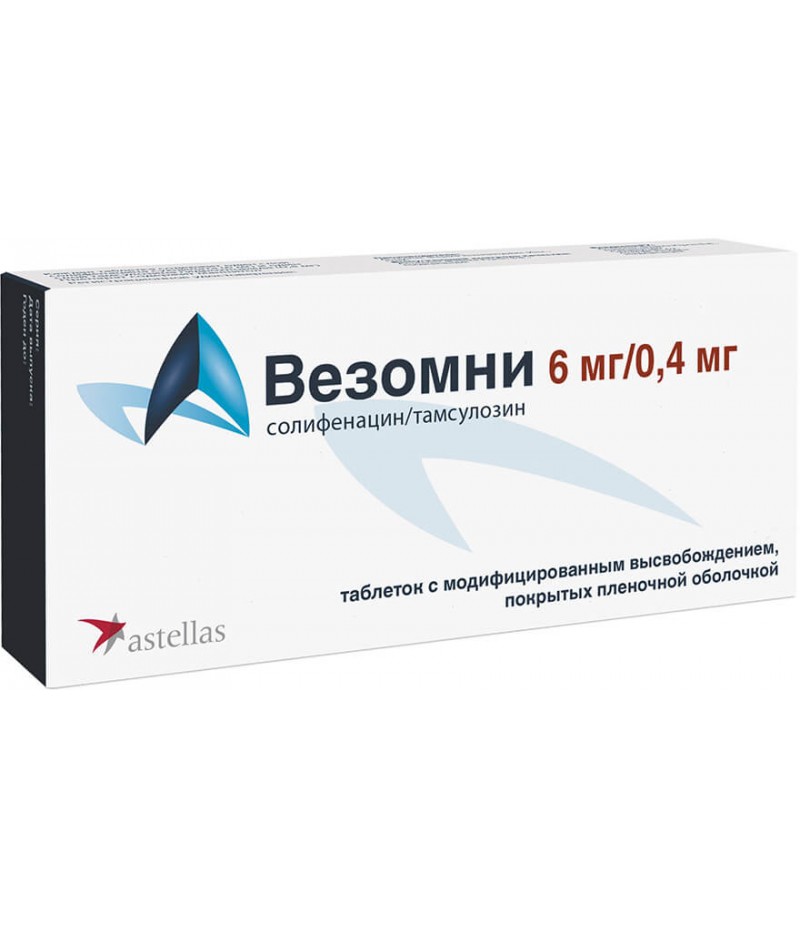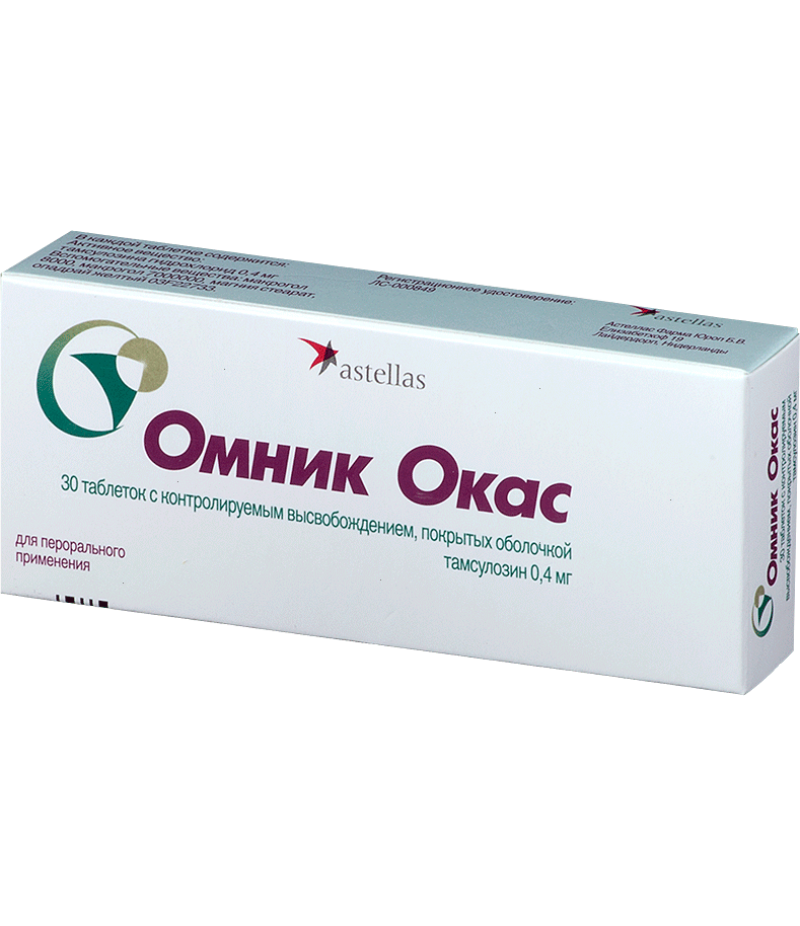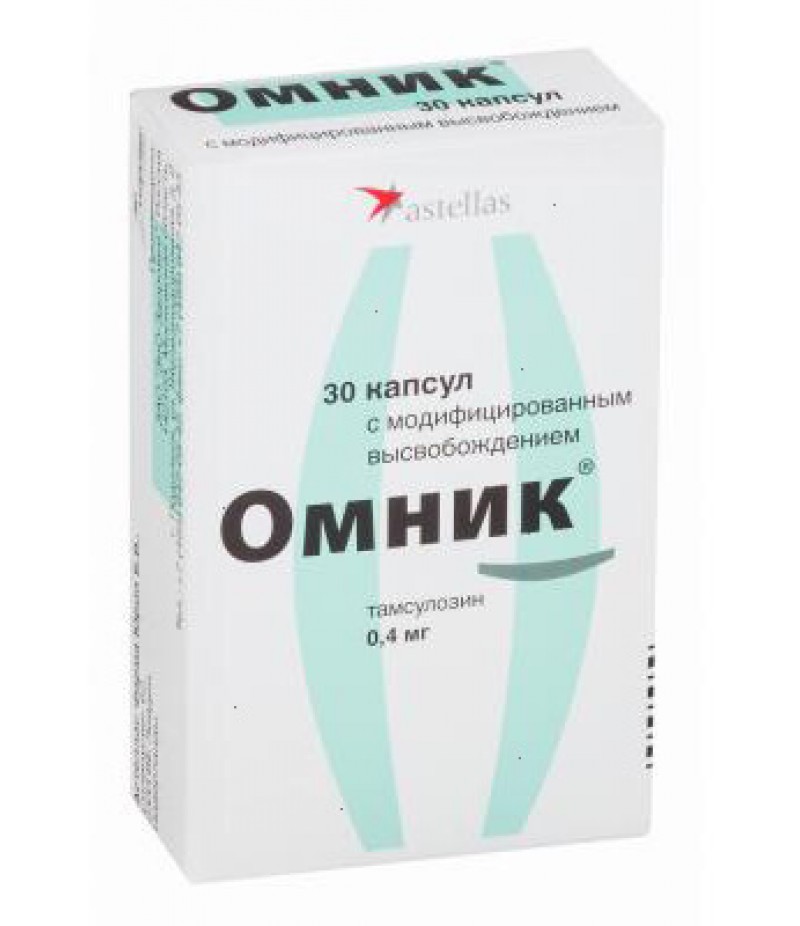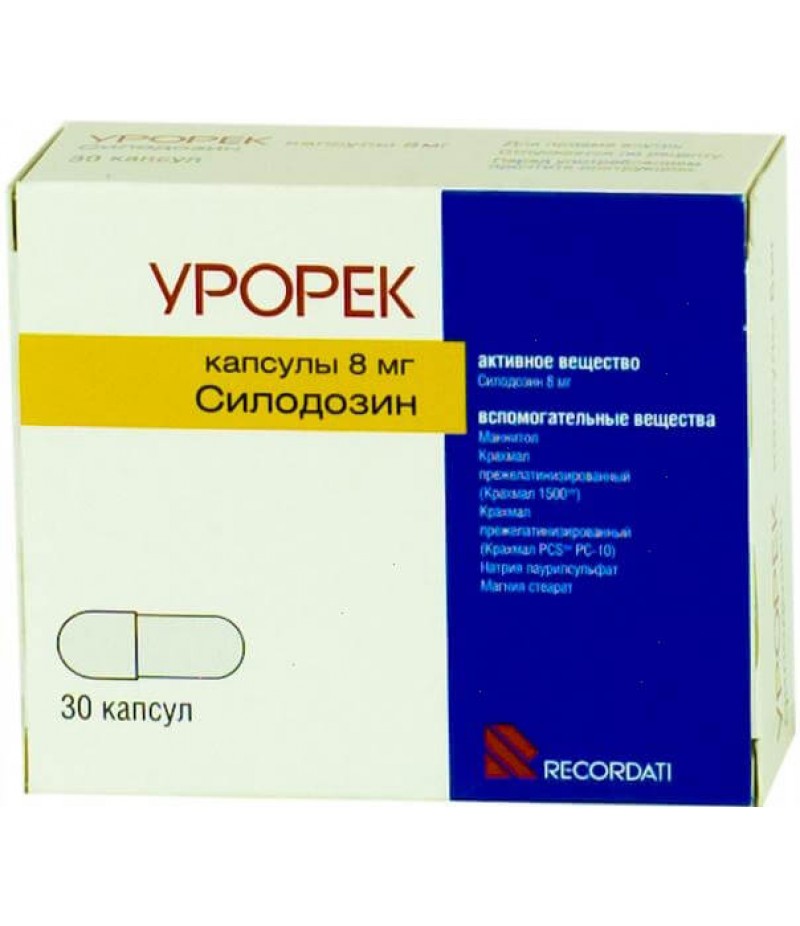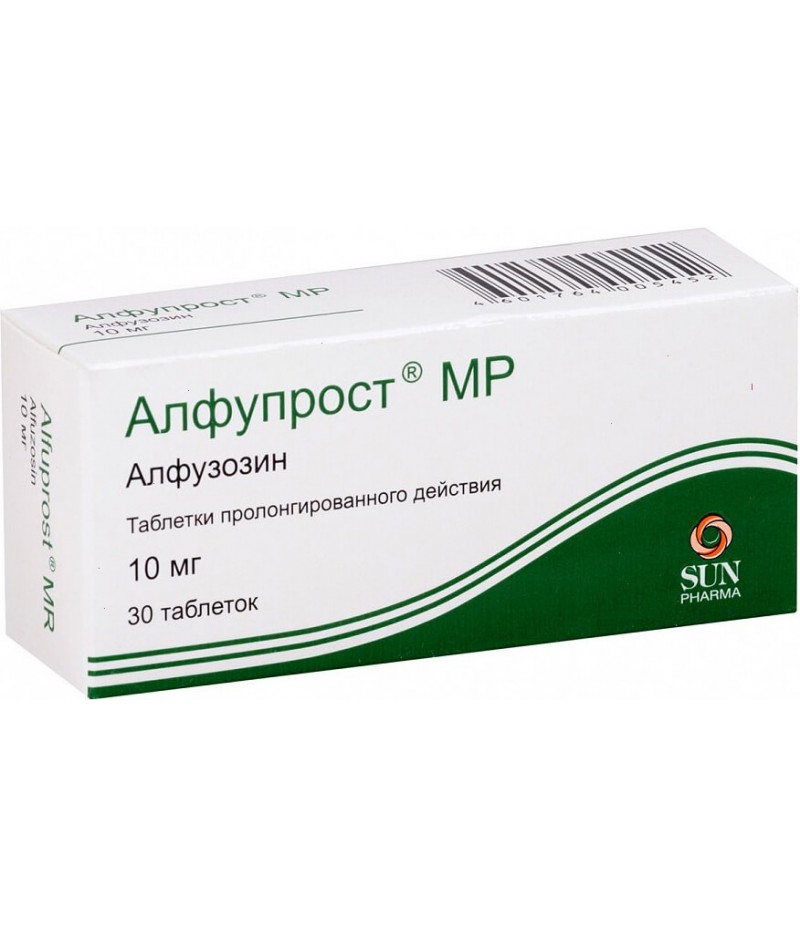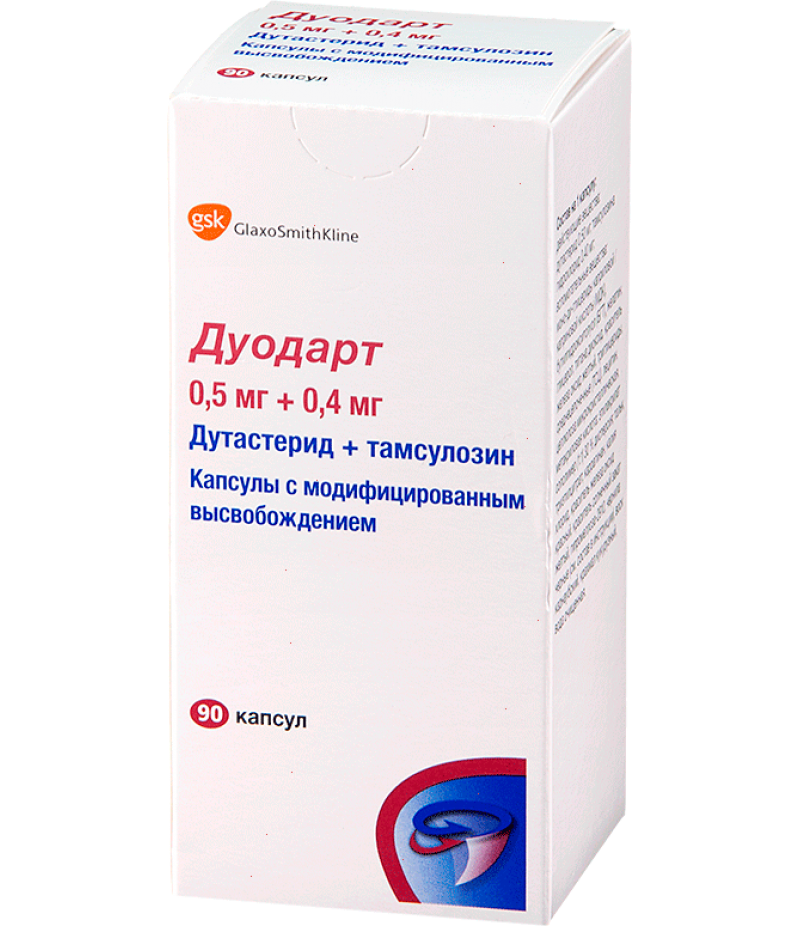Vezomni tabs 6mg + 0.4mg #30
- $76.24
- 2 or more $75.20
- 3 or more $73.99
- Availability:In Stock
Vezomni instruction for useYou can buy Vezomni hereComposition1 tablet contains:Active substances: solifenacin succinate 6.0 mg, tamsulosin hydrochloride 0.4 mg,Excipients: mannitol 83.0 mg, maltose 10.0 mg, magnesium stearate 2.2..
Tags: tabs
Vezomni instruction for use
You can buy Vezomni here
Composition
1 tablet contains:
Active substances: solifenacin succinate 6.0 mg, tamsulosin hydrochloride 0.4 mg,
Excipients: mannitol 83.0 mg, maltose 10.0 mg, magnesium stearate 2.2 mg, macrogol 7 000 000 200.0 mg, macrogol 8 000 40.0 mg.
Packaging - 10 and 30 pieces
pharmachologic effect
The drug Vezomni is a combination drug containing two active ingredients, solifenacin and tamsulosin. These active ingredients have independent and complementary mechanisms of action for the treatment of lower urinary tract symptoms (LUTS) in benign prostatic hyperplasia (BPH), in the presence of symptoms of bladder filling.
Solifenacin is a selective competitive antagonist of muscarinic receptors, does not have affinity for other receptors, enzymes or ion channels. Solifenacin has a high affinity for muscarinic M 3 receptors, and a lower affinity for muscarinic M 1 and M 2 receptors.
Tamsulosin is an alpha 1 -adrenoreceptor blocker. Tamsulosin binds selectively and competitively to postsynaptic alpha 1 -adrenoreceptors, especially the alpha 1 A and alpha 1D subtypes, which are responsible for relaxing the smooth muscles of the lower urinary tract.
Solifenacin alleviates the symptoms of bladder filling (irritative symptoms) associated with the action of acetylcholine, which activates M 3 cholinergic receptors in the bladder. Acetylcholine activates the contractile function of the bladder wall, manifested as an urgent urge to urinate or urinary incontinence.
Tamsulosin improves the symptoms of emptying, increasing the maximum flow rate of urine, reduces the symptoms of obstruction, relaxing the smooth muscles of the prostate gland, bladder neck and urethra. It also improves urine filling in the bladder.
Pharmacokinetics
A bioavailability study with repeated intake showed that the pharmacokinetics when taking Vezomni is compared with the pharmacokinetics while taking solifenacin and tamsulosin.
Suction
After taking Vezomni multiple times, the time to reach the maximum concentration of T Max for solifenacin varies between 4.27 and 4.76 hours in various studies, for tamsulosin between 3.47 and 5.65 hours, respectively. The maximum plasma concentration (C Max) for solifenacin varied between 26.5 ng / ml and 32.0 ng / ml, for tamsulosin, between 6.56 ng / ml and 13.3 ng / ml. The area under the concentration-time curve for solifenacin ranged from 528 ng / h / ml to 601 ng / h / ml, and tamsulosin ranged from 97.1 ng / h / ml and 222 ng / h / ml. The bioavailability of solifenacin was about 90%, while tamsulosin is absorbed by 70% - 79% of the dose applied.
A study was conducted on the Vezomni drug when a single dose was applied simultaneously with a meal, with a low-fat meal, with a low-calorie breakfast, and with a high-fat meal and a high-calorie meal. After a high-fat meal, a high-calorie breakfast, there was an increase in C max for tamsulosin by 54% compared with an empty stomach drug, in which the AUC increased by 33%. The pharmacokinetics of solifenacin do not change with a low-fat meal, with a low-fat breakfast, or with a high-fat meal or a high-calorie meal.
The simultaneous use of solifenacin and tamsulosin OCAS leads to an increase in C max by 1.19 times and an increase in the AUC of tamsulosin by 1.24 times compared to the AUC of tamsulosin OCAS in monotherapy. There are no indicators of the effect of tamsulosin on the pharmacokinetics of solifenacin.
Removal
After a single dose of Vezomni, the half-life of t 1/2 of solifenacin ranged from 49.5 hours to 53 hours; tamsulosin - from 12.8 hours to 14 hours.
Repeated use of verapamil in a dose of 240 mg simultaneously with Vezomni drug leads to an increase in solifenacin - C max by 60% and AUC by 63%, while for tamsulosin C max increases to 115% and AUC - to 122%. Changes in C max and AUC are not clinically significant.
An analysis of pharmacokinetic data during phase 3 clinical trials shows the variability of the pharmacokinetics of tamsulosin depending on the age, height and concentration of α 1 in the blood - an acidic glycoprotein. An increase in AUC is associated with an increase in α 1 - an acidic glycoprotein and age, while a decrease in AUC is associated with a decrease in growth. In addition, an increase in gammaglutamyl transferase is associated with high AUC values. These changes in AUC values are not clinically significant.
Information on the pharmacokinetics of the active ingredients of the combined drug complements the pharmacokinetic properties of the drug Vezomni.
Solifenacin
Suction
The time to reach the maximum concentration of T Max does not depend on the dose and ranges from 3 to 8:00 after taking several doses. The value of C Max and AUC increase in proportion to the dose from 5 to 40 mg. Bioavailability is approximately 90%.
Distribution. The volume of distribution of solifenacin after administration of the drug is about 600 liters. Approximately 98% of solifenacin binds to plasma proteins, primarily with the α 1 -acid glycoprotein.
Metabolism. Solifenacin is metabolized slowly, has a low first-pass effect. Solifenacin is extensively metabolized in the liver, mainly with the participation of CYP3A4. However, there are alternative metabolic pathways that can affect the metabolism of solifenacin. The solifenacin system clearance is about 9.5 l / h. After administration in plasma, one pharmacologically active metabolite (4R-hydroxysolifenacin) and three inactive metabolites (N-glucuronide, N-oxide and 4R-hydroxy-N-oxide solifenacin) were determined (except for solifenacin).
Removal. After a single dose of 10 mg of 14 C-labeled solifenacin, about 70% of radioactivity was detected in the urine and 23% in the feces within 26 days. In the urine, approximately 11% of the radioactivity was detected in unchanged form in the form of the active substance, about 18% as an N-oxide metabolite, 9% as a 4R-hydroxy-N-oxide metabolite and 8% as a 4R-hydroxymetabolite (active metabolite).
Tamsulosin
Suction For tamsulosin in the form of OCAS, T Max is in the range from 4 to 6:00 after several doses of 0.4 mg / day. C Max and AUC increase in proportion to the dose of 0.4 to 1.2 mg. Absolute bioavailability of 57%.
Distribution. The volume of distribution of tamsulosin after administration is about 16 liters. Approximately 99% of tamsulosin binds to plasma proteins, primarily with the α 1 -acid glycoprotein.
Metabolism. Tamsulosin has a low first-pass effect, it is slowly metabolized. Tamsulosin is extensively metabolized in the liver, mainly with CYP3A4 and CYP2D6. The systemic clearance of tamsulosin is about 2.9 l / h. Most of the tamsulosin used is present in plasma as the unchanged active substance. None of the metabolites was more active than the original substance. Conclusion. In the case of a single dose of 0.2 mg of 14 C-labeled tamsulosin, after 1 week of treatment, about 76% of the radioactivity is excreted in the urine and 21% in the feces. In the urine about 9% of radioactivity was found unchanged in the form of tamsulosin, about 16% - as sulphate of diethyl tamsulosin, and 8% - as etoxyfenoxyl-acetic acid.
Characteristics in special patient groups
Elderly patients
In clinical pharmacology and bioavailability studies, the age of patients ranged from 19 to 79 years. After the use of the drug Vezomni, high concentrations were found in elderly patients, although there was an almost complete coincidence with individual indicators in younger patients. The drug Vezomni can be used in elderly patients.
Renal failure
The drug Vezomni is used in patients with mild to moderate renal insufficiency, but caution should be exercised when used in patients with severe renal insufficiency.
The pharmacokinetics of the drug Vezomni has not been studied in patients with renal insufficiency.
The following data reflects information about renal failure characteristic of each of the active ingredients of the drug.
Solifenacin
AUC and C Max solifenacin in patients with mild and moderate severity differ slightly from the corresponding indicators in healthy volunteers. In patients with severe renal insufficiency (creatinine clearance ≤ 30 ml / min), the exposure of solifenacin is much higher - the increase in C Max is about 30%, the AUC is more than 100% and t 1/2 is more than 60%. There was a statistically significant relationship between creatinine clearance and solifenacin clearance. Pharmacokinetics in patients undergoing hemodialysis has not been studied.
Tamsulosin
The pharmacokinetics of tamsulosin were compared in 6 patients with mild to moderate renal failure (30≥ creatinine clearance
Liver failure
The drug Vezomni is used in patients with moderate to moderate hepatic insufficiency, but is contraindicated in patients with severe hepatic insufficiency.
The pharmacokinetics of the drug Vezomni has not been studied in patients with hepatic insufficiency.
The following data reflects information about liver failure characteristic of each of the active ingredients of the drug.
Solifenacin
In patients with moderate hepatic impairment (7–9 points on the Child-Drink scale), the CMax value does not change, the AUC increases by 60%, and t 1/2 is doubled.
Pharmacokinetics in patients with severe hepatic impairment has not been studied.
Tamsulosin
Tamsulosin pharmacokinetics were compared in 8 patients with moderate hepatic insufficiency (7–9 on the Child-Pugh scale) and in 8 healthy patients. Changes in the total concentration of tamsulosin in the blood plasma due to changes in the connection with α 1 -oxidized glycoprotein, the active concentration of tamsulosin hydrochloride was markedly unchanged, and the internal clearance of inactive tamsulosin was moderate (32%). The pharmacokinetics of tamsulosin in patients with severe hepatic insufficiency has not been studied.
Vezomni, indications for use
Treatment of symptoms of bladder filling (imperative urination, frequent urination) of moderate and severe and symptoms of bladder emptying (obstructive symptoms) associated with benign prostatic hyperplasia (BPH) in men who do not have monotherapy.
Contraindications for Vezomni
Hypersensitivity to the active substances or to any of the excipients. Hemodialysis. Severe liver failure. Severe renal failure, which use powerful inhibitors of cytochrome P450 (CYP) 3A4, such as ketoconazole. Mild liver dysfunction, which also use powerful inhibitors of CYP3A4, such as ketoconazole.
Severe gastrointestinal diseases (including toxic megacolon), myasthenia gravis or glaucoma and the presence of risks of developing these diseases. A history of orthostatic hypotension.
Dosage and administration
Adult men, including older men.
Take orally 1 tablet of the drug Vezomni (6 mg / 0.4 mg) once a day, regardless of the meal. The maximum daily dose of the drug Vezomni is 1 tablet (6 mg / 0.4 mg). The tablets are taken whole, not chewed but not crushed.
Patients with renal failure. The effect of renal failure on the pharmacokinetics of the drug Vezomni has not been studied. However, the effect on the pharmacokinetics of individual active ingredients of the drug has been well studied (see Section “Pharmacokinetic properties”). The drug Vezomni can be prescribed to patients with mild and moderate renal insufficiency (creatinine clearance> 30 ml / min). For patients with severe renal insufficiency (creatinine clearance ≤ 30 ml / min), use the drug with caution and not exceed the maximum daily dose.
Patients with impaired liver function. The effect of hepatic insufficiency on the pharmacokinetics of Vesomney has not been studied. However, the effect on the pharmacokinetics of individual active ingredients of the drug has been well studied (see Section “Pharmacokinetic properties”). Vezomni can be prescribed to patients with mild hepatic insufficiency (Child-Pugh ≤ 7). Patients with moderate hepatic insufficiency (assessment on the Child-Pugh scale 7-9) should use the drug with caution and not exceed the maximum daily dose. For patients with severe liver failure (Child-Pugh rating> 9), the use of the drug Vezomni is contraindicated.
Moderate and potent inhibitors of cytochrome P450 ZA4. Vezomni should be used with caution in patients who are simultaneously treated with moderate or strong CYP3A4 inhibitors (such as verapamil, ketoconazole, ritonavir, nelfinavir, itraconazole).
Children
The drug is not intended for use in children (under the age of 18 years).
Interaction
Interactions with inhibitors of CYP3A4 and CYP2D6.
The simultaneous use of solifenacin ketoconazole (a potent CYP3A4 inhibitor) at a dose of 200 mg / day resulted in a 1.4- and 2.0-fold increase in C Max and AUC of solifenacin, while the administration of ketoconazole at a dose of 400 mg / day resulted in a 1.5 - and 2.8-fold increase in C Max and AUC of solifenacin.
With simultaneous use of tamsulosin with ketoconazole at a dose of 400 mg / day, a 2.2- and 2.8-fold increase in C Max and tamsulosin AUC were observed, respectively.
With simultaneous use of tamsulosin with cimetidine, a weak CYP3A4 inhibitor (400 mg every 6:00), a 1.44-fold increase in tamsulosin AUC was observed, whereas C Max did not change significantly. The drug Vezomni can be used simultaneously with weak inhibitors of CYP3A4.
The simultaneous use of tamsulosin with paroxetine, a potent inhibitor of CYP2D6 (20 mg per day) resulted in a 1.3 and 1.6 fold increase in C Max and AUC of tamsulosin, respectively. The drug Vezomni can be used simultaneously with CYP2D6 inhibitors.
The effect of induction enzymes on the pharmacokinetic properties of solifenacin and tamsulosin has not been studied. Since solifenacin and tamsulosin is metabolized by CYP3A4, pharmacokinetic interactions with inducers of CYP3A4 (for example rifampicin) are possible, which can reduce the concentration of solifenacin and tamsulosin in the blood plasma.
Other interactions
Solifenacin
Solifenacin can reduce the effects of drugs that stimulate the motility of the gastrointestinal tract, such as metoclopramide and cisapride. In vitro studies of solifenacin have indicated that therapeutic concentrations of solifenacin do not inhibit CYP1A1 / 2, 2B6, 2C8, 2C9, 2C19, 2D6, 2E1 or 3A4, therefore no interactions are expected between Solifenacin and drugs that are metabolized with these CYP enzymes . Taking solifenacin does not change the pharmacokinetics of R-warfarin or S-warfarin, or their effect on prothrombin time. Solifenacin has been shown to have virtually no effect on digoxin pharmacokinetics.
Tamsulosin
The simultaneous use of tamsulosin with other blockers alpha 1 - adrenergic receptors can lead to hypotensive action. In vitro studies, the amount of tamsulosin free fraction in human plasma did not change with the simultaneous use of drugs such as diazepam, propranolol, trichlormethiazide, chlormadinone, amitriptyline, diclofenac, glibenclamide, simvastatin or warfarin. Tamsulosin does not change the amount of the free fraction of diazepam, propranolol, trichloromethiazide or chlormadinone. Although diclofenac and warfarin may increase the rate of elimination of tamsulosin. Simultaneous use with furosemide leads to a decrease in plasma tamsulosin levels, but since tamsulosin levels remain within the therapeutic range, simultaneous use of tamsulosin and furosemide is acceptable. In vitro studies of tamsulosin have shown that at therapeutic concentrations tamsulosin does not virtually suppress CYP1A2, 2C9, 2C19, 2D6, 2E1, or 3A4. Therefore, no interactions are expected between tamsulosin and drugs that are metabolized with the participation of data from CYP enzymes. There are no cases of tamsulosin interaction with simultaneous use with atenolol, enalapril or theophylline.
Overdose
Symptoms Overdose with a combination of solifenacin and tamsulosin can potentially lead to severe anticholinergic effect with the development of acute arterial hypotension. The highest doses, taken by chance during clinical trials, were 126 mg of solifenacin succinate and 5.6 mg of tamsulosin hydrochloride. These doses were well tolerated, when administered for 16 days of treatment, moderate dry mouth was reported.
Treatment
In the case of an overdose of the drug solifenacin and tamsulosin, the patient should take activated charcoal. Gastric lavage may be useful during the first hour after taking the drug, but should not induce vomiting.
Symptoms of solifenacin overdose, like other anticholinergic drugs, can be treated as follows:
severe anticholinergic effects on the central nervous system, hallucinations or other pronounced disorders: treatment with the use of physostigmine or Carbachol;
convulsions or severe irritability: treatment with benzodiazepines;
respiratory failure: treatment with the use of artificial respiration;
tachycardia symptomatic treatment, if necessary. Beta blockers should be used with caution, since concomitant tamsulosin overdose can potentially cause severe hypotension;
urinary retention: catheterization.
As with other antimuscarinic drugs, in case of overdose, special attention should be given to patients with an established risk of developing a prolongation of the QT interval (for example, with hypokalemia, bradycardia, and simultaneous use of drugs that can prolong the QT interval) and corresponding to pre-existing heart diseases ( eg myocardial ischemia, arrhythmia, heart failure).
Acute hypotension, which is possible with an overdose of tamsulosin, should be treated symptomatically. Since tamsulosin binds to plasma proteins very well, hemodialysis is unlikely.
Terms of sell
You don't need a prescription to buy Vezomni.

